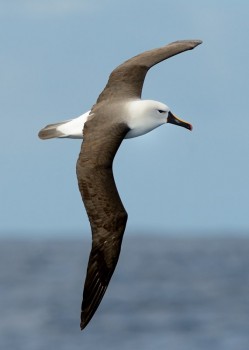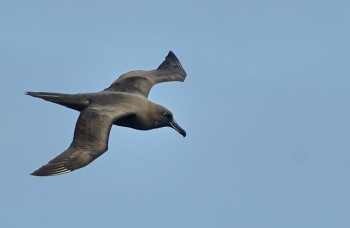
île Saint-Paul from the air. Photograph by Thierry Micol
île Saint-Paul and the adjacent islet of La Roche Quille are located 85 km south of île Amsterdam in the southern Indian Ocean. The uninhabited island forms part of the French Southern and Antarctic Territories (Terres Australes et Antarctiques Françaises - TAAF). Since 2006 the whole island and its territorial waters have been classified as a National Nature Reserve. The island was designated as part of a Ramsar Wetland of International Importance in 2008 (click here). Saint-Paul has also been designated an Important Bird Area by BirdLife International.

île Saint-Paul’s flooded crater with La Roche Quille behind. Photograph by Jeremie Demay

The southern coast of île Saint-Paul. Photograph by Jeremie Demay
Saint-Paul is a young volcano where the caldera has collapsed allowing the sea to overrun the crater. This small island, of only eight square kilometres, hosts two species of albatrosses, the only ACAP-listed species that breed. The Indian Yellow-nosed Albatross Thalassarche carteri occurs in a small colony of less than 10 pairs on the inside of the crater while less than 50 pairs of Sooty Albatrosses Phoebetria fusca breed annually on the island’s coastal cliffs.


Indian Yellow-nosed and Sooty Albatrosses at sea in the southern Indian Ocean
Photographs by Mark Zufelt
In 1997 the Black or Ship Rat Rattus rattus and European Rabbit Oryctolagus cuniculus were successfully eradicated from the island by dropping poison bait from a helicopter. Despite the continued presence of the House Mouse Mus musculus on the island (which was not eradicated in 1997), recent visits have shown slow recolonisation by burrowing petrels, especially by the endemic Macgillivray’s Prion Pachyptila [salvini] macgillivrayi.
Selected References:
Chapuis, J.-L., Boussès, P. & Barnaud, G. 1994. Alien mammals, impact and management in the French subantarctic islands. Biological Conservation 64: 97-104.
Duriez, O. & Delord, K. 2012. Manchots, petrels et albatross: oiseaux des Terres australes et antarctiques françaises (TAAF). Ornithos 19-3: 162-183.
Duriez, O., Jornvaal, H. & Shirihai, H. 2005. Birds and wildlife of the French sub-Antarctic islands: Crozet, Kerguelen and Amsterdam & St Paul. Dutch Birding 27: 87-115.
Micol, T. & Jouventin, P. 19 . Eradication of rats and rabbits from Saint-Paul Island, French Southern Territories. In: Veitch, C.R. & Clout, M.N. (Eds). Turning the Tide: the Eradication of Invasive Species. Proceedings of the International Conference on Eradication of Island Invasives. Gland, Switzerland & Cambridge, UK: IUCN SSC Invasive Species Specialist Group. pp. 199-205.
Ministère de l'Écologie et du Développement Durable 2008. Décret No. 2006-1211 du 3 octobre 2006 portant creation de la reserve naturelle des Terres australes françaises. Journal Officiel de la République Française. 4 octobre 2006. 4 pp.
TAAF 2006. Instructions sur la protection de l'environnement dans les Terres australes antarctiques françaises. Saint-Pierre: Terres australes et antarctiques françaises. 9 pp.
TAAF 2010. Plan de gestion 2011 - 2015 Réserve naturelle des Terres australes françaises. Saint Pierre, La Réunion: Terres australes et antarctiques françaises. 35 pp.
Fabrice Le Bouard, Centre d'Etudes Biologiques de Chizé, Villiers-en-Bois, Beauvoir-sur-Niort, France, 02 July 2013

 English
English  Français
Français  Español
Español